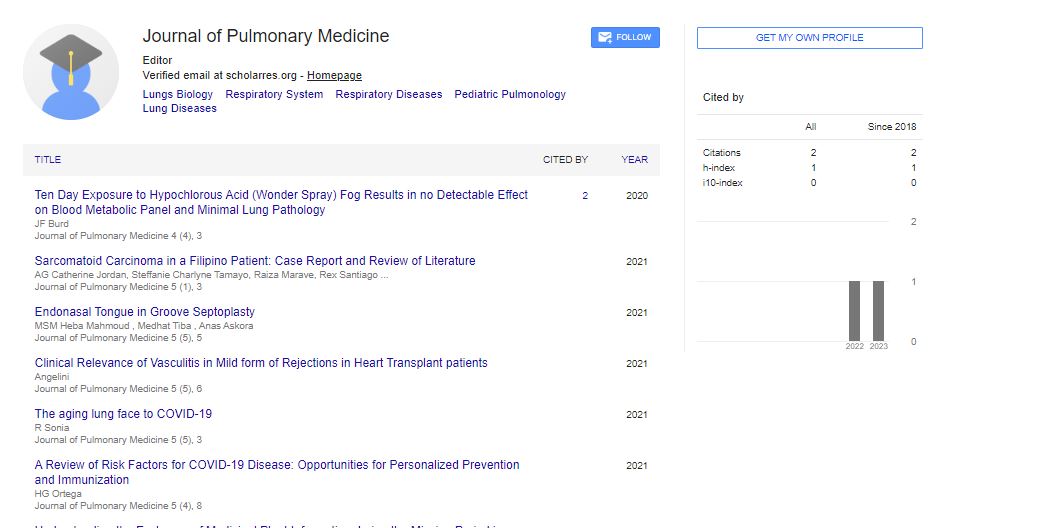Case Report, J Pulm Med Vol: 4 Issue: 2
Fatal Case of Non-culturable Meningitis with Pulmonary Embolism
Tracy Butler
Pisespong Patamasucon, M.D. Pediatric Infectious Diseases,Rocky Mountain Hospital for Children Denver, Colorado
Abstract
A 16 year old girl with past history of anxiety, depression, and anorexia presents with malaise, fatigue, severe neck stiffness and pain. She also had abdominal pain with non-bilious vomiting which had been worsening for 1 week. Three days earlier she was admitted in our hospital with mono-like symptoms, enlarged liver and spleen, as well as lingual nerve palsy. After consulting with Pediatric Neurology she was treated with steroids and discharged home. However, after discharge she continued to have severe malaise and diffuse body aches, especially in the right upper shoulder and neck. She also had an occipital headache and right sided abdominal pain. During this period she was afebrile.
Keywords: Meningitis,Pulmonary, Embolism
Vital signs: T 36.9 C, RR 22 breaths per minute, Pulse 103 beats per minute, and BP 108/92 mmHg. The work up for her initial presentation includes WBC 5620, 82% neutrophils, 3% bands, 14% lymphocyte, CRP 26.5 mg/dL (nl 0-0.8 mg/dL), D-Dimer 1745 (nl 215-500ng/mL). Other chemistry: Sodium 133 mmol/L, Potassium 3.3 mmol/L, Chloride 103 mmol/L, BUN 20 mg/dL, Creatinine 0.5 mg/dL, Total bilirubin 1.6 mg/dL, AST 37, ALT 58, Alk PO4 160.
Upon physical examination, the patient was found to be afebrile, but had stiff neck with enlarged lymph node on the left side. She had no respiratory distress with normal breath sounds, normal heart sounds with tachycardia. Her abdomen was soft and non-tender with no distention and spleen tip was palpable. Neurologically she was alert with equal bilateral reflexes with intact CNS cranial nerve except mild leftward tongue deviation when extended.
A CT showed no acute hemorrhage, no midline shift or no mass effect, no evidence of acute infarct, and only mild to moderate left sphenoid sinus mucosal thickening with fluid level.
In the ER, Ceftriaxone 2 gm was given.
There were many unsuccessful attempts of lumbar puncture until later done by PICU attending physician. When it was obtained, the CSF opening pressure >55 cm of H2O done two hours after the first dose of antibiotic. CSF WBC 3661, 96% PMN, glucose <5 mg/dl, protein 429 mg/dL, RBC 1000.
Due to her worsening clinical status, the patient was intubated in the Emergency Department and transferred to the PICU. Vancomycin and Metronidazole were added including Micafungin as soon as she was admitted to the PICU. After 3 hours of admission to the PICU her pupils were found to be unequal so an emergency CT was done that showed dilated ventricle. Emergency ventriculostomy was done, however her neurological status deteriorated with progression of large bilateral ischemia, bilateral frontal lobes, parietal lobes, and midbrain/basal ganglion. She developed a transforaminal downward herniation of the cerebellar tonsils.
There was no surgical option or further treatment of herniation available and therefore she was placed under sedation and passed.
Cultures were taken from her sinuses and specimens were sent for bacterial and fungal. Her blood, urine, and CSF did not grow any bacteria or fungus by culture or serology. The bacteria antigen PCR that was collected prior to death from sinus aspiration was positive for Fusobaterium necrophorum. The diagnosis of Lemierre Syndrome was confirmed based on the findings of a brain abscess by MRI, pulmonary emboli and jugular vein thrombosis by CT scan, along with sinus organism which was positive for Fusobacterium necrophorum.
The disease was first described by French physician Dr. André-Alfred Lemierre as postanginal sepsis characterized by septic thrombophlebitis of the jugular vein. Pharyngitis is the most common preceding infection. It can also be caused by a dental infection, ear infection, or mononucleosis. Septic embolization is common, particularly in the lungs. Fusobacterium necrophorum is most often found as the causative agent, but other oropharyngeal bacteria have been reported.
The patient had a history of infectious mononucleosis due to EBV infection 2 weeks earlier and was treated with steroids. The combination of EBV and steroid use has been shown to be associated with Lemierre Syndrome.
The proposal of pathogenesis of this syndrome started from tonsillar infection with Fusobacterium necrophorum leading to lateral pharyngeal spread to deep neck septic thrombophlebitis. The Fusobaterium necrophorum bacteremia from the internal jugular vein led to lung abscess and meningitis/brain abscess.
In order to make a diagnosis of Lemeirre Syndrome, the clinician should have a high index of suspicion in a patient with severe pharyngitis and high fever with chills, no cough or runny nose, tender cervical lymphadenopathy, and progressive neurologic and respiratory symptoms. These symptoms will persist beyond 3 days.
Lemierre Syndrome is rare following the introduction of antibiotic usage in the 1960s. Over the 3 decades the disease has become obsolete. It is extremely uncommon and therefore very difficult to diagnose because jugular vein thrombosis is not readily seen by CT scan of the lung. Blood cultures rarely grow Fusobacterium necrophorum when patients have received multiple antibiotics or when aerobic cultures are solely sent. Fusobacterium necrophorum is usually sensitive to metronidazole, clindamycin, penicillin G, Meropenem and piperacillin-tazobactam.
References
- Ramirez S, Hild TG, Rudolph CN, et al. Increased diagnosis of Lemierre syndrome and other Fusobacterium necrophorum infections at a Children's Hospital. Pediatrics. 2003;112(5):e380. doi:10.1542/peds.112.5.e380
- Alvarez A, Schreiber JR. Lemierre’s syndrome in adolescent children— anaerobic sepsis with internal jugular vein thrombophlebitis following pharyngitis. Pediatrics. 1995;96:354–359
- Screaton NJ, Ravenel JG, Lehner PJ, et al. Lemierre syndrome: forgotten but not extinct—report of four cases. Radiology. 1999;213:369–374
- Gold WL, Kapral MK, Witmer MR, et al. Postanginal septicemia as a life-threatening complication of infectious mononucleosis. Clin Infect Dis. 1995;20:1439–1440
 Spanish
Spanish  Chinese
Chinese  Russian
Russian  German
German  French
French  Japanese
Japanese  Portuguese
Portuguese  Hindi
Hindi 